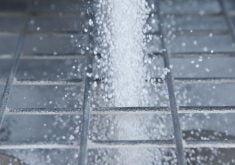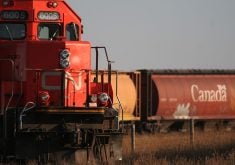Alberta farmer says re-conditioner boosted both hay quality and butterfat content produced by dairy cows
Butterfat content from Jim Harper’s dairy cows increased from 3.8 percent in 2013 to a highly profitable 4.2 percent last year when he fed them hay treated with his new ReCon 400.
Dairy farmers make money on butterfat, and butterfat numbers like those at Harper’s Rose City Dairy near Camrose make other farmers stand up and take note.
Harper knew when he bought the re-conditioner that it would give him better hay and butterfat numbers, but this much of a jump came as a surprise.
“The hay we made ourselves this year (2014) is far better than what we were forced to buy the past four years when ours wasn’t good enough. Our butterfat went from 3.8 with purchased hay last year up to 4.2 with our own hay this year,” Harper said.
Read Also

Fertilizer method’s link to emissions studied
A researcher says others studying greenhouse gas emissions aren’t considering how the loss of nitrogen into the atmosphere correlates with fertilizer application or if there is an impact to yield.
“That’s just pure money in the bank when it comes to dairy. If I was feeding beef, I wouldn’t be so picky about it. But in dairy, that’s our profit.”
The quality of hay in a dairy barn translates directly to a farm’s profit.
“When you’re forced to buy hay, you’re letting someone else control your destiny, but if you can put up quality hay yourself, then you’re in control,” he said.
“This is the first time in four years I’ve made my own hay that’s good enough quality for dairy. I’ve had to buy hay for the past four years, and that hurts.”
Harper said the weather hasn’t been kind to his hay for the past four years. Rain often fell a day before the crop would have finished curing.
Rose City Dairy has 200 acres of hayland, which is cut three times a summer. While researching re-conditioners, Harper decided he could be self-sufficient in hay if he could just shorten the drying time by two days.
He’s convinced the ReCon purchase may have been one of his smartest farming decisions, but said he still hasn’t tapped the full potential.
The machine is designed specifically to turn two individual 18 foot windrows into a single windrow for more efficient baling.
The economic threshold for a new piece of equipment like this is the point where the operator eliminates one field pass with one machine. In this instance, the ReCon 400 twin swath feature is intended to eliminate one pass with the rake.
“I didn’t do that,” he said.
“I didn’t even try the twin swath feature. I wanted to, but in the end, I chickened out. It’s a new machine and I wasn’t familiar with it, so this year I just wanted to make sure the hay was cured before baling.”
Another touted benefit of the machine is its ability to gently lift a swath and set it on dry ground next to the strip where it had been laying.
“When I get out of the cab and touch the ground where the swath had been, then touch the ground next to the swath, there’s no comparison. The ground where the swath had been is very damp. Very moist,” he said.
“The swath retains its shape and its form when the machine sets it back down again. It’s still fluffy and airy. There doesn’t seem to be any rough treatment of the hay and we’re not losing any leafy material.”
However, Harper had one unhappy surprise.
Ag Shield recommends that the ReCon 400 be run within six hours after cutting to avoid the hay sticking to the rollers as the syrupy sap is squeezed from the stems.
However, he ignored the advice the first time he used it.
“That sap really sticks to the crimper. Lots of grief. It’s about 20 minutes wasted every time you stop to clean it off. That’s a lesson we learned the hard way,” he said.
“Now, in all fairness, I have to admit they warned us. They made it clear we’d be sorry if we didn’t do our re-conditioning right away. It’s nobody’s fault but our own. In fact, they were so sure we’d gum it up that they left me with a scraper that looks like it’s made just for that purpose.”
For more information, contact Harper at 780-672-0337 or visit www.agshield.ca.
ron.lyseng@producer.com

















